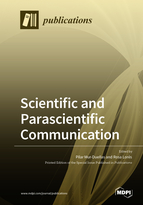Scientific and Parascientific Communication
A special issue of Publications (ISSN 2304-6775).
Deadline for manuscript submissions: closed (30 September 2021) | Viewed by 31499
Special Issue Editors
Interests: scholarly communication; scientific digital discourse; English for academic purposes; intercultural rhetoric; corpus studies; genre theory
Special Issue Information
Dear Colleagues,
There is an increasing need for scholars and scientists to not only conduct research that has a significant impact on society but also to communicate that research widely. Such research outreach contributes to disseminating and transferring new knowledge and, also, very importantly, to engaging wide, diverse audiences. Disseminating scientific knowledge and engaging the public is of paramount importance for funding and accountability reasons. As such, discursive practices have become more and more complex, multimodal, and multimedia-based for scholars and scientists. In addition, such dissemination frequently entails stakeholders and has the potential to blur the boundaries between expert and non-expert communication.
The existence of the Internet and of the various platforms it affords both responds and provides an answer to well-established and new social and communicative needs. As a result, scientific communication is currently shared to a great extent with peers through conventional genres (i.e., abstracts, research papers, book reviews, or reports) which may be reconfigured and reshaped in technology-mediated contexts. Such contexts also allow opening formal scientific publication to public viewing. Alongside this so-called “primary output” (Puschmann 2015), new ways, modes, and discourses are being used to bring science closer to a lay audience and to promote citizen participation. The affordances of existing and emergent platforms are fostering a change in audience roles, and with it, the erosion of boundaries between scientific communities and the general public, which entails disseminating scientific information and knowledge beyond the former (Trench 2008).
Within this context, we are witnessing the development of discursive practices which may be referred to as instances of “parascientific communication”. These practices go beyond the dichotomy between internal or expert (members of the scientific community) and external or non-expert (diverse publics) and transcend previously well-delimited communities and spheres of communication. Parascientific genres are evolving based on authoritative or expert knowledge (communicated through conventional, sanctioned scientific genres) but not subjected to the filters of internal, formal science communication (Kelly and Miller 2016).
With this Special Issue, we seek to respond to questions such as the following:
- To what extent does parascientific communication differ from scientific communication? Which features characterize them?
- Which new discoursal practices are emerging in response to boundary erosion in scientific communication? What do they entail? Who undertakes these? What functions do they fulfill?
- Can well-established methodological approaches be useful and valid to explore digital communication, either scientific or parascientific? What new perspectives might contribute to the exploration of new practices?
We thus welcome contributions that address the analysis of scientific and parascientific communication taking one or several of the following theoretical and methodological perspectives, among which are included:
- Genre Studies
- Pragmatic Approaches
- Multimodal Analysis
- Ethnographic Explorations
- Intercultural and Multilingual Approaches
- Translation Studies
Dr. Pilar Mur-Dueñas
Dr. Rosa Lorés
Guest Editors
References
Kelly, A.R.; Miller, C.R. Intersections: Scientific and Parascientific Communication on the Internet. Science and the Internet: Communicating knowledge in a digital age. Gross, A., Buehl, J., Eds.; Baywood: Amityville, NY, USA, 2016; 221–245.
Puschmann, C. A Digital Mob in the Ivory Tower? Context Collapse in Scholarly Communication online. Discourse In and Through the Media: Recontextualizing and Reconceptualizing Expert Discourse. Bondi, M., Cacchiani, S., Mazzi, D. Eds.; Cambridge Scholars Publishing: Newcastle upon Tyne, UK, 2015; 22–45.
Trench, B. Internet—Turning Science Communication Inside‐Out? Handbook of Public Communication of Science and Technology. Bucchi, M., Trench, B. Eds.; Routledge: London, UK; New York, NY, USA, 2008; 185–198.
Manuscript Submission Information
Manuscripts should be submitted online at www.mdpi.com by registering and logging in to this website. Once you are registered, click here to go to the submission form. Manuscripts can be submitted until the deadline. All papers will be peer-reviewed. Accepted papers will be published continuously in the journal (as soon as accepted) and will be listed together on the special issue website. Research articles, review articles as well as short communications are invited. For planned papers, a title and short abstract (about 100 words) can be sent to the Editorial Office for announcement on this website.
Submitted manuscripts should not have been published previously, nor be under consideration for publication elsewhere (except conference proceedings papers). All manuscripts are thoroughly refereed through a single-blind peer-review process. A guide for authors and other relevant information for submission of manuscripts is available on the Instructions for Authors page. Publications is an international peer-reviewed open access quarterly journal published by MDPI.
Please visit the Instructions for Authors page before submitting a manuscript. The Article Processing Charge (APC) for publication in this Special Issue will be fully waived. Submitted papers should be well formatted and use good English. Authors may use MDPI's English editing service prior to publication or during author revisions.
Keywords
- digital scientific communication
- digital parascientific communication
- public communication of science
- scientific discursive practices
- expert/non-expert communities
- erosion of audience boundaries
- technology-mediated discourse
- citizen science
- knowledge dissemination







